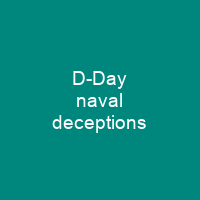Operations Taxable and Glimmer: A D-Day Deception
Imagine a scenario where the Allies were playing a high-stakes game of chess, but with their moves hidden from the enemy’s view. That’s exactly what happened on June 6, 1944, during Operation Overlord, better known as D-Day.
In this strategic battle for Normandy, two key operations, Taxable and Glimmer, were designed to mislead the Germans about the location of the Allied invasion force. These operations were part of a larger deception plan called Operation Fortitude, which aimed to make the German High Command believe that the main landing would take place at Pas-de-Calais rather than Normandy.
Taxable and Glimmer: The Deception Tactics
How did they pull off this elaborate trick? By using a combination of small boats, aircraft, and radar countermeasures. Taxable, for instance, involved 18 small boats that were equipped with chaff to create the illusion of a large fleet approaching Cap d’Antifer. Meanwhile, Glimmer used six Short Stirling bombers from No. 218 ‘Gold Coast’ Squadron, each carrying two pilots who rotated flying duties.
The Naval Component: Operation Taxable
Imagine a fleet of small boats, each one a tiny ship in the vast ocean of deception. These boats, known as HDMLs (Hedgehog Motor Launches), were part of Special Task Force B under Lieutenant Commander W.M. Rankin. Each boat was equipped with jamming gear, radios, and radar-reflecting balloons to further confuse German radars. The operation began in the early hours of D-Day, and by 13:00 on that day, all boats had returned safely to port.
The Airborne Component: Operation Glimmer
Now picture six bombers flying over the skies, their mission to create a false radar image. These Short Stirling bombers were part of No. 218 Squadron and carried chaff to simulate a large fleet approaching Pas-de-Calais. Each aircraft had two pilots who took turns at the controls, ensuring that no single pilot was fatigued during this critical operation.
The Response from German Forces
Glimmer elicited more response from the Germans than Taxable. Reconnaissance planes were sent to investigate what appeared on radar screens as a large invasion fleet. This reaction was encouraging, suggesting that the deception had worked and that the Germans believed in the authenticity of the threat.
The Other Operation: Big Drum
While Taxable and Glimmer were busy drawing German forces away from Normandy, another operation called Big Drum was launched to create a diversion on the western flank. This involved four HDMLs operating as a distraction. However, this operation failed to elicit any significant response from the Germans, making it less effective than its counterparts.
The Success of Deception Operations
Taxable, Glimmer, and Big Drum were part of a larger strategy to mislead the German High Command. While the success of these operations is unclear due to poor weather conditions and lack of response from the Germans, they played a crucial role in diverting attention away from Normandy.
The lessons learned from Operation Fortitude continue to influence military strategies today, reminding us that deception can be as powerful a weapon as any. The next time you hear about a successful military operation, remember the small boats and bombers of D-Day, working together to create a grand illusion.

Remember, the key to success in any operation is often not just in the execution but also in the ability to deceive and mislead. The operations of June 6, 1944, stand as a testament to the power of strategic deception in warfare.
You want to know more about D-Day naval deceptions?
This page is based on the article D-Day naval deceptions published in Wikipedia (retrieved on November 28, 2024) and was automatically summarized using artificial intelligence.







